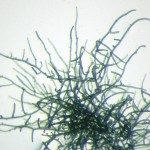Link to Pubmed [PMID] – 17632212
Water Res. 2007 Nov;41(19):4446-56
The dynamics and microcystins (MC) concentrations of a perennial Planktothrix agardhii bloom were investigated in a eutrophic lake (Viry-Châtillon, France). A weak relationship was observed between P. agardhii population biomass and the MC concentrations in a 1-year survey. To further investigate the causes of MC concentration changes, we concurrently conducted experiments on 41 strains isolated from this lake. We first checked the clonal diversity of P. agardhii population (i) by molecular techniques, to assess the presence of MC synthetase gene (mcyB), (ii) by biochemical assay (PP2A inhibition assay), for MC production, and (iii) by mass spectrometry (MS), to identify the MC chemotypes. Our results illustrated the diversity of genotype and MC chemotypes within a P. agardhii natural population. Eleven chemotypes among the 16 possible ones were found by MS. Furthermore, we noticed major differences in the MC content of isolated strains (from 0.02 to 1.86 microg equiv. MC-LR mg DW(-1), n=25). Growth and MC production of one MC-producing strain and one non-MC-producing strain were also assessed at two temperatures (10 and 20 degrees C). We showed that growth capacities of these strains were similar at the two tested temperatures, and that the MC production rate was correlated to the growth rate for the MC-producing strain. On the basis of these results, several hypotheses are discussed to explain the weakness of relationships between natural P. agardhii biomass and MC concentration. One of the main reasons could lie in the proportion of MC-producing clones and non-MC-producing clones that may change during the sampling period. Also, the MC-producing clones may present different intracellular MC content due to (i) MC chemotypes diversity, (ii) changes in MC variants proportions within a strain, and (iii) changes in MC rate production depending on the physiological state of cells. Finally, we concluded that various biological organization levels have to be considered (population, cellular and molecular), through an integrative approach, in order to provide a better understanding of P. agardhii in situ MC production.

